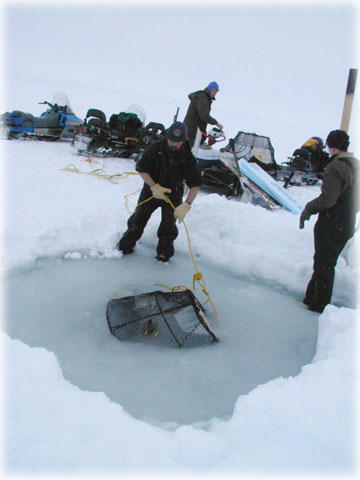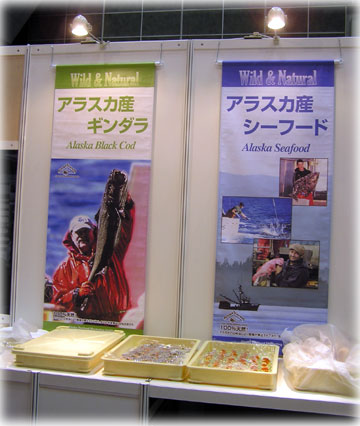 Alaska's king crab harvests By Laine Welch July 24, 2005
Each summer since 1977, red king crab has been harvested from far away Norton Sound. Starting on July 1 through mid-August, a fleet of about 30 local crabbers, mostly in boats under 32 feet, hauls in up to 400,000 pounds of red kings from waters ranging from Cape Romanzof up to Cape Prince of Wales.
That wasn't always the case. In the late 1970's and early '80's, a flotilla of large boats from elsewhere would steam into Norton Sound and take away two million pounds of king crab in a week. Managers changed the rules in 1994 and turned it into a "super exclusive" registration, meaning boats fishing in any other Bering Sea crab fishery could not drop pots at Norton Sound. It is a region where king crab has become increasingly important, especially with other fisheries remaining in a slump. "We've had trouble getting buyers for herring, there's no interest in our chums, and until this summer, we haven't even had a fishery for king salmon. So our best fishermen have turned their attention to crab," said Jim Menard, area management biologist for Norton Sound and Kotzebue. There's been no problem finding buyers, and all of the crab is committed even before it's caught. For example, Red Lobster in Toronto, Canada, takes all it can get. "For the past five years they've been using our crab in that one region," said Tom Magwire of Norton Sound Seafoods. The company provides Red Lobster with about 130,000 pounds of frozen crab that is a "unique pack just for them." Magwire added that it is listed on menus as Norton Sound red king crab. "That is a requirement," he said. Crab also goes to eager buyers in the fresh, whole cooked market. Working with a broker who specializes in shellfish, Norton Sound Seafoods sends out 5,000 pounds a week to supermarkets in places like Florida and Las Vegas. "We cook it one day and it's in stores 48 hours later," Magwire said. Norton Sound is not just the source of Alaska's only summer king crab - it also is the state's first winter crab fishery. Amazingly, it is done through the ice. "It's done on show machines, and they use power saws or augers to cut a big square and drop cone shaped pots through the ice. Pictures of it make quite an impression at annual management meetings," said Jim Menard with a laugh. "The fishery opens in mid-November, but since we don't have a good ice base, it usually gets underway after New Year's," he added. The fishery yields up to 25,000 pounds of king crab, depending on ice conditions. Most of it is sold locally, although 300-400 pounds of live crab is shipped each week to New Sagaya in Anchorage, Tom Magwire said. Norton Sound harvesters average $3.00 a pound for their king crab ($4.00 in the winter), and the fishery brings in more than $1 million to the region each year. At least for the near term, its future looks secure. Yearly tagging studies show the crab stocks are continuing to make a come back, and two strong year classes have recruited into the fishery.
Tom Magwire credits the Norton
Sound Economic Development Corporation for developing the infrastructure
to make the region's small boat fisheries a success. "Nome
is a regular seaport now," he said. "If it wasn't for
them, it wouldn't have happened. The novelty product is already
on retail shelves in various outlets in Alaska, Washington and
Oregon. "People are ordering more, so that's a good sign,"
said Witteveen. Both entrepreneurs hope that as Americans become
more aware of the health benefits of salmon, their product will
take a big bite out of the beef jerky market. And they
believe their salmon sticks can serve a loftier goal. "Hopefully,
there is no limit to the amount of fish we can use to saturate
the snack food market," Witteveen said. "Our end goal
is to have a successful company and make a positive impact on
Alaska's salmon industry. I really think it can make a difference."
Get details at www.wildsalmonjerky.com . ASMI is also taking the lead
to introduce younger generations of Japanese to all things Alaska.
In partnership with the Genuine Alaska Pollock Producers (GAPP),
ASMI sponsored a media tour a few weeks ago. "It's been
13 years since that's been done," Dochtermann said. The
group toured Bristol Bay to see the salmon fishery, and Dutch
Harbor and Akutan for an up close look at the whitefish industry.
"We've got some generational changes going on with consumers
and businesses," Dochtermann said. He added: "In fact,
all of the media that came over were younger folks who were getting
a new education about Alaska. You could see the wonder in their
faces and it's important for us to create that awareness."
He pointed out that Japan remains as Alaska's most important
customer, purchasing at least half of all seafood exports.
Publish A Letter on SitNews Read Letters/Opinions Submit A Letter to the Editor
|
|||

